Propping up the wall: how to rescue a leaning tower Understand article
Civil engineer John Burland talks about the perils and practicalities of supporting some of the world’s most iconic buildings.
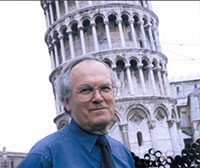
tower he helped to save, in
Pisa
Image courtesy of John Burland
One of the joys of being a civil engineer, believes John Burland, is that “every single project is unique; no buildings are alike”. There is, however, one feature shared by most of the buildings on which John has worked: they seem to have been in danger of falling down.
Most famously, John was one of the engineering experts called on in 1990 to help rescue the Leaning Tower of Pisa, Italy, but the Big Ben clock tower in London, UK, and even the Metropolitan Cathedral in Mexico City have also benefitted from his expertise.
Rescuing the Big Ben clock tower

was built underneath the
Houses of Parliament in
1979, John was called in to
make sure that the Big Ben
clock tower (on the right)
did not become another
leaning tower.
Image courtesy of Moyan Brenn
/ Flickr
The Big Ben project was not so much a rescue as damage limitation. As a soil mechanics engineer, John was already involved in deep excavation projects in London when the decision was taken in the early 1970s to build a multi-storey car park underneath the Houses of Parliament and the Big Ben tower. John was approached to help with the design and construction, to ensure that the state buildings would not be damaged by the work on the 20 m-deep car park beneath. The fear was that another famous leaning tower might be created, this time in London.
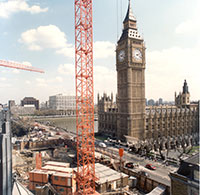
station under construction at
Westminster
Image courtesy of John Burland
Constant monitoring was crucial to the project, as John recollects: “My team was involved in taking measurements as the car park was constructed, and we discovered all sorts of unexpected things – as you do when you take measurements. For example, we predicted that the Big Ben clock tower would move towards the east, and it actually moved westwards. We got the amount right, but we got the direction wrong, and we had to explain to Black Rod [the House of Lords official] why, even though we were out by 180°, it wasn’t a serious mistake!”
Mistake or not, John’s expertise was again called on years later when, in the early 1990s, an even deeper excavation was needed for an underground train line being run beneath the Houses of Parliament. Again John’s team managed both to measure and to control the movement – by pumping cement into the ground before the excavation started – but not without a lot of attention from the media. “The press got very excited about it, and we still get questions occasionally, and see headlines such as ‘The Palace of Westminster is about to subside into the River Thames’,” John says.
John has had a lot of practice at dealing with the international press, as well as in tackling technical issues. So how does he approach this? “My line is to tell it as it is – say what the technical challenges are and how you’re trying to meet them. I don’t believe you can do anything else,” he says.
How it all began
As an engineering student, John initially disliked the discipline of soil mechanics, in which he is now regarded as such a prominent expert, but warmed to it while studying for his PhD at the University of Cambridge. After Cambridge, he joined the Building Research Establishment (BRE) in London, a UK government research organisation that had pioneered the study of soil mechanics. “I wanted to go there and work on real buildings, and find out how they really behaved,” he says.

project was on the Sydney
Opera House, Australia.
Image courtesy of jimmyharris
/ Flickr
At BRE John worked on his first high-profile project – the Sydney Opera House – and honed his skills in foundations and excavations. “I had a wonderful 16 years at BRE working on all sorts of projects, but one in particular required digging deep excavations in urban areas,” he says. “So I began to get involved with some of the deep excavations that were taking place in London – the Barbican Arts Centre, for example, which was a huge excavation in the City of London. And because of this work, I was asked to become involved with the Houses of Parliament car park. That became a seminal project that was published in the engineering journals. And I guess it was because of my involvement with that that I got involved with Pisa.”
The Leaning Tower of Pisa in danger
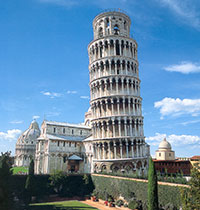
pictured before John’s work
on it began, is surrounded by
mythology.
Image courtesy of John Burland
This was in 1990, when the famous Leaning Tower of Pisa was leaning rather too far for comfort. Not only that, but a medieval tower in the northern Italian town of Pavia had collapsed the previous year, killing four people. So the Italian government set up a multidisciplinary commission of international experts to prevent the Pisa tower meeting the same fate, and John was asked to join it.
In the beginning, not everyone agreed that the tower needed saving. “There was this huge mythology about the tower. People were saying ‘Don’t touch it, it’s quite safe as it is; if you do anything to it, it’ll fall over’,” says John. “There was a quote from the mayor saying ‘It’s in the Piazza dei Miracoli [the Square of Miracles], so it’ll never fall down’. So our job was to bring some science to bear.”
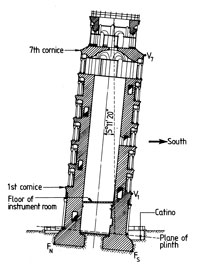
Leaning Tower of Pisa, before
John and his colleagues
began their work to rescue it.
Click on image to enlarge.
Image courtesy of John Burland
The first step was to investigate how the tower had been built originally, to understand why it was leaning. The team discovered that the tower had probably begun to lean from day one. “You can see tapered layers of masonry, showing that the builders were trying to correct the slant even as they were building it,” says John.
He and other technical experts spent two years trying to understand why the tower was leaning and what was controlling its movements, which was absolutely fundamental to solving the problem, John believes. “Up until then, people had just proposed solutions at random, but until you really understand things, you’re likely to get it wrong.”
They discovered that the leaning was caused by a combination of the tower’s dimensions and the type of ground it was built on, as John explains: “The ground there is so soft that it’s like foam rubber, and in this situation there’s a critical height for a building of a given weight and diameter before it starts to lean and fall over. And the Pisa tower is exactly at that critical height: amazing.”
So the tower was hovering between stability and collapse. “It was going to fall over, but it was impossible to say when – a storm or an earthquake could have finished it off. So we had to do some very urgent work if we were to stabilise it,” John says.
The problem is that once a tower starts leaning, it becomes increasingly unstable. “As the inclination increases, the centre of gravity moves, producing an additional overturning force,” he explains. “So it gets worse and worse, and then it collapses.” At the time, the tower was moving at about 1.5 mm a year, but the movement was accelerating – which was terrifying, John says.
Of course, working on such iconic buildings involves more than just engineering. “The problem was incredibly complex, because we had to obey the laws of conservation of ancient monuments, which forbid you to change the character of the monument. So you couldn’t go and stick a great big prop on one side,” John says. “And it had to continue leaning: the Italians didn’t want a vertical Leaning Tower.”
Stabilising the Leaning Tower
The team’s solution was inspired by the tunnelling work that John had already carried out in London. “When you drill a tunnel in the ground, you always cause the ground to settle a little bit. And I thought that if we could magically induce the ground to settle a little bit on the high side of the foundations, we could perhaps reduce the inclination of the tower enough to make it stable,” he says. “So we came up with this idea of extracting small amounts of soil, rather like mini-tunnels.”
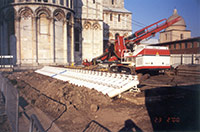
solution to stabilising the
Leaning Tower of Pisa
Image courtesy of John Burland
But there was a risk that putting any idea into practice could itself make the tower topple. “There were all sorts of ideas about what you could do to stabilise the tower, and all of them would work if you could implement them, but implementing them would cause the tower to fall over,” says John. So the team did a huge amount of computer analysis and precise monitoring to test the tunnelling approach before going ahead. “In the end we extracted about 70 cubic metres [of soil], a couple of lorries full, so it was really quite small,” he says.
But the monitoring and historical investigations had also revealed another factor: the tower leaned further to the south in winter than in summer. “Originally I thought this was something to do with the sun going round the tower, but then we began to measure the way the water table changes seasonally. Whenever there is a rainstorm – and in Tuscany they get incredibly heavy rain storms in the winter – the water table comes up a little bit more on the north [high] side than on the south [low] side, so it lifts the north side and pushes the tower further to the south. So in addition to reducing the inclination, we had to stabilise the water table,” says John.
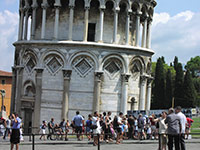
after John’s work, is still
leaning, but more stable.
Image courtesy of tiseb / Flickr
The solution to this problem was engineering of a much more standard type, as John explains: “We put in some drains on the north side, which ran the water into wells that are kept at a constant level by discharging into a conduit. That’s all been in operation since about 2006, and it really has stabilised the water table. And that’s one of the major reasons why the movement has stopped.”
So is the tower now permanently secure and stable? “We’ve continued our measurements for the past three or four years and for all practical purposes it’s not moving,” he says.
Saving Latin America’s oldest cathedral
Remarkably, at the same time as he was in the international spotlight for the Pisa project, John was also working on another endangered historical building, this time in Mexico City. As in Pisa, the problem was that one side of the Metropolitan Cathedral − the oldest and largest cathedral in Latin America − was subsiding more than the other. Once again, changes in the water table were found to be the underlying cause, as John explains.

of Mexico City, the oldest
and largest cathedral in Latin
America, photographed
during John’s work on it
Image courtesy of John Burland
“Mexico City was founded on an old volcanic lake of very, very soft volcanic sediments, which are incredibly compressible,” he says. “Pumping water from beneath that area for the city’s water supply has caused the ground to settle, literally by metres. That has caused huge problems, because the settlement isn’t uniform. Half of the Metropolitan Cathedral is built on an area where an old Aztec temple once stood, which compressed the ground and made it much firmer. But the other half was built on undisturbed ground, so the cathedral underwent these vast differential settlements of 1.5 metres and more.”
The result is that, over the 300 or so years of the cathedral’s existence, it has cracked badly, and in the 1990s the movement was still continuing. Coincidentally, the experts in Mexico were considering soil extraction to stabilise the cathedral at the same time as John was proposing this approach for the Pisa tower. “They were doing it in a very different way, but the principle was the same,” he says. “Three of us on the Pisa commission got involved with the Mexican cathedral because of that link.” The soil extraction successfully evened out the rate of sinking across the cathedral’s foundations, greatly reducing the risk of further cracking.
So is a building ever in such a bad state that John would advise just giving up? “The decision is probably economic in the end, but it’s also a question of how important the building is historically,” he says.
And buildings don’t get any more important historically than the Leaning Tower of Pisa. To enhance the success of the engineering work, the tower has now been cleaned – as John had the pleasure of seeing on a recent visit. “It’s now absolutely mind-blowing, this beautiful white marble tower, dramatically leaning, with the most beautiful inlays and patterns in the marble. It absolutely takes your breath away,” he says.
Engineering in the classroom
John is understandably passionate about this unique building, regarding the Pisa project as perhaps his most satisfying achievement in a lifetime of daring projects. But he is also passionate about teaching, and believes that a truly hands-on approach is the right way to engage the next generation of scientists and engineers.
“My experience with children is that they long to get their hands on things,” he says. “And in some senses I’m quite dismayed at how the virtual world, through the computer, is replacing that. You can computerise models, but it’s not the same as giving children something to handle and to push and prod, because that’s the way you really cultivate curiosity and the intrinsic understanding of how things work.”
This philosophy seems to have become a hallmark of the Burland approach to teaching, as John says: “I’m well known for bringing physical models into class, and I bump into former students all over the place who say, ‘Oh, Professor Burland, I’ll never forget the model you showed us of such and such’. Because they remember models; they don’t remember equations.”
Acknowledgement
This article is based on an interview given by Professor John Burland to the editor-in-chief of Science in School, Dr Eleanor Hayes.
Resources
- Published by the UK’s Royal Academy of Engineering, Ingenia magazine offers articles about engineering written for the non-specialist.
- In 2005, Ingenia published an interview with John Burland.
- For a further interview with John Burland, see:
- Smith D (2009) Engineering beats Pisa’s problem. Physics Education 44(3): 311-313. doi: 10.1088/0031-9120/44/3/M02
Review
This article offers an insight into the life and work of an engineer: his decision to study engineering, how science and engineering methods are combined, and his small and large projects. The Leaning Tower of Pisa and its problems are well known, but it is especially exciting to be told the story of how it was saved by the man who did it.
The topic is interdisciplinary, can be easily understood without much knowledge of physics, and, because the article is written like an adventure, can be used in many ways and to enhance the teaching of several subjects. Teachers can find their own ways of using the article, for example in geography, general science, history, physics or engineering lessons, but also in language lessons, to read and translate the article. For students aged 10-15, I would recommend the article for general reading, while older students can benefit from it in the context of lessons on engineering.
The article is also suitable for comprehension questions such as:
- What problems may occur if massive buildings are built on unstable ground? Describe these problems in detail.
- Which methods can be used to stabilise unsafe ground and how do they work?
Gerd Vogt, Higher Secondary School for Environment and Economics, Yspertal





